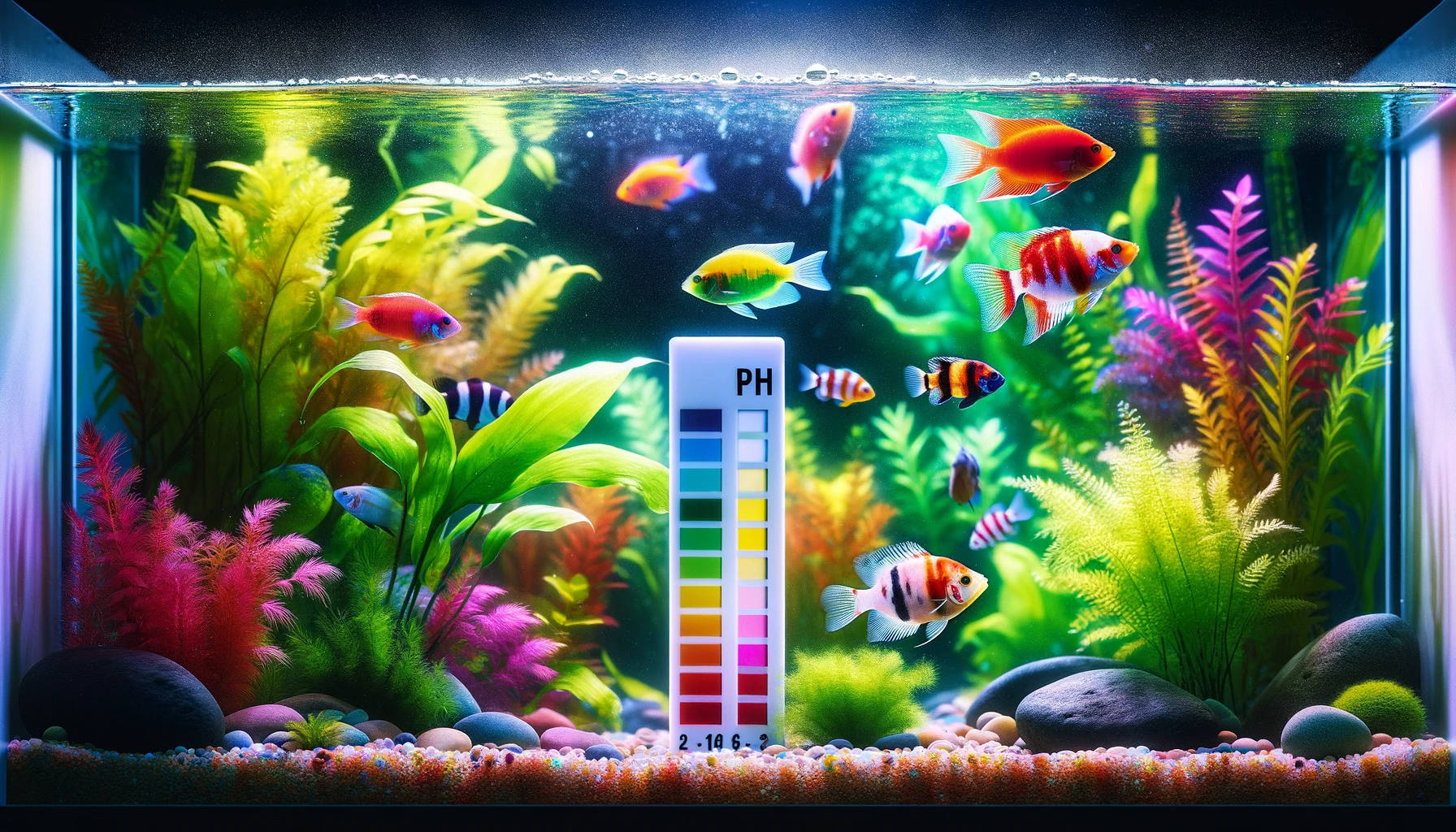Welcome to our comprehensive guide on Aquarium Water Chemistry, focusing on the pivotal role of pH levels in freshwater fish tanks.
This article offers valuable insights into maintaining optimal conditions for aquatic life, detailing how pH balance affects your tank’s ecosystem.
We provide essential advice on monitoring and adjusting pH levels, ensuring the health and vitality of your fish.
Whether you’re a seasoned aquarist or a beginner, our guide equips you with the knowledge to create a stable and thriving aquatic environment.
## Key Takeaways
– pH is an important parameter in aquarium water chemistry as it measures the acidity or basicity of the water.
– Different fish species have different pH preferences based on their natural habitats.
– Factors such as water source, substrate, aquarium decorations, filtration, fish and plants, and chemical additives can all affect pH levels in an aquarium.
– Regular monitoring and maintenance of stable pH levels are crucial for the health and well-being of the fish and other aquarium inhabitants.
Understanding Aquarium pH Level
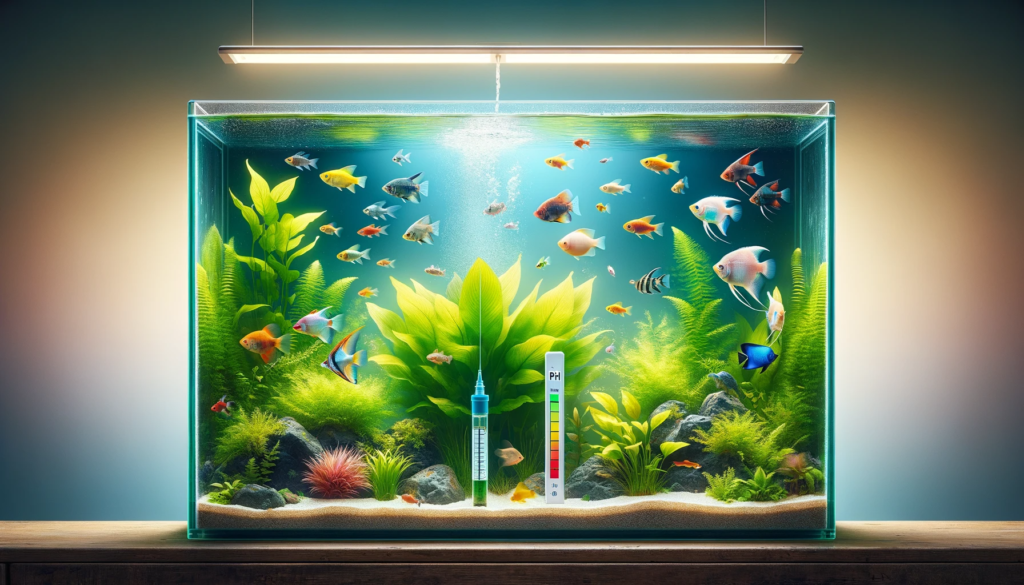
pH, short for “per Hydrion,” is a term you might not be familiar with. It relates to the concentration of hydrogen ions, termed “Hydrion,” in a solution – in this context, aquarium water. The pH scale is logarithmic, meaning each whole number change represents a tenfold increase or decrease in acidity. For instance, a pH of 6.0 is ten times more acidic than 7.0, and 5.0 is a hundred times more acidic than 7.0.
To understand pH fluctiations, you need to know what causes water to be acidic (below 7.0) or basic (above 7.0). Hydrogen ions (H+) make water acidic, while hydroxide ions (OH-) make it basic. Combining these ions forms H2O, or water, making pure water neutral with a pH of exactly 7.0. However, aquarium pH isn’t stable without the presence of minerals like Calcium, Magnesium, Sodium, Iodine, Chloride, etc. These minerals are what the measures of Carbonate Hardness (KH) and General Hardness (GH) indicate.
So, how does this impact your fish? Well, aside from specific species like African cichlids, most fish thrive in water with a pH between 6.6 and 8.2. Fish are highly adaptable and can usually adjust to these conditions. The key is maintaining a consistent pH, even if it’s at the extremes of the scale, rather than trying to achieve an exact value. This stability is more crucial for fish health than maintaining a precise pH level.
Importance of a stable pH level in a freshwater aquarium
Maintaining a stable pH level in a freshwater aquarium is crucial for the health and well-being of its aquatic inhabitants, as sudden fluctuations can lead to stress and disease. The right pH balance allows fish to regulate their internal equilibrium, ensuring vital biological processes function properly.
Each species has an optimal pH range, often mirroring their natural environment. Deviations can impair immune response, affect breeding, and cause discomfort or mortality. Regular monitoring and maintenance of pH levels are therefore indispensable to prevent adverse effects.
Moreover, a stable pH supports the effectiveness of the aquarium’s biological filtration system, which relies on beneficial bacteria that thrive within specific pH parameters. Careful management of pH is a fundamental aspect of successful aquarium husbandry.
Key factors influencing the pH level in a fish tank
In light of the preceding discussion on the importance of stable pH levels, several key factors play pivotal roles in influencing the acidity or alkalinity within a freshwater fish tank environment. Understanding these factors is crucial for maintaining a healthy aquarium:
Water Source
– Tap or well water with inherent pH levels
Substrate
– Gravel or sand releasing minerals affecting pH
Aquarium Decorations
– Driftwood and rocks introducing substances that modify pH
Filtration
– Filter types, such as activated carbon, influencing pH stability
Fish and Plants
– Specific species preferences impacting water chemistry
Chemical Additives
– pH adjusters or buffers used for direct alteration
Regular monitoring is essential to safeguard the well-being of the aquatic ecosystem.
How pH level fluctiations affect fish
Fluctuations in pH levels can induce stress in fish, potentially leading to weakened immunity and increased susceptibility to disease. Each species of fish has an optimal pH range that corresponds to their native environment. Deviations from this range can disrupt physiological processes, causing discomfort and health complications.
In an aquarium setting, maintaining a stable pH level is crucial for the well-being of the aquatic life. Rapid or frequent changes in pH can shock fish, leading to fatal outcomes, particularly in young or already weakened specimens. It is essential to monitor pH regularly and make adjustments carefully, aiming for gradual changes to avoid stressing the fish.
A stable and species-appropriate pH level supports a healthy ecosystem within the tank, fostering a thriving aquatic community.
What is the ideal pH range for a freshwater aquarium?
The ideal pH range for most freshwater fishes is between 6.5 and 7.5. However, it is important to note that different species of fish may have specific pH requirements.
Some species may tolerate slightly higher or lower pH levels, so it is always recommended to research the specific needs of the fish species you are keeping.
Additionally, sudden and drastic changes in pH can be harmful to fish, so maintaining a stable pH level is crucial for their health.
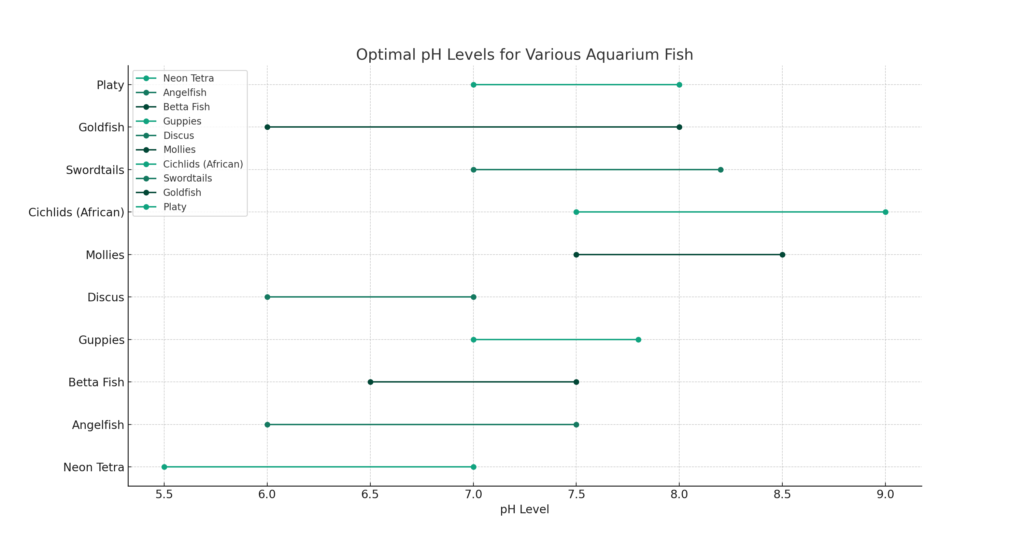
- Goldfish (Carassius auratus):
- pH Range: 6.0 to 8.0
- Goldfish are hardy and can adapt to a range of water conditions, making them a popular choice for beginners.
- Guppies (Poecilia reticulata):
- pH Range: 6.8 to 7.8
- Guppies are adaptable and can thrive in various water conditions. They are also known for their vibrant colors and active behavior.
- Mollies (Poecilia sphenops):
- pH Range: 7.0 to 8.5
- Mollies are adaptable to a range of pH levels and are available in several varieties and colors.
- Zebra Danios (Danio rerio):
- pH Range: 6.0 to 8.0
- These are hardy, active, and easy to care for, making them suitable for a variety of water conditions.
- Swordtails (Xiphophorus hellerii):
- pH Range: 7.0 to 8.4
- Swordtails are known for their distinctive tail fin and can adapt to a wide pH range.
- Betta Fish (Betta splendens):
- pH Range: 6.0 to 8.0
- While bettas prefer slightly acidic water, they are quite resilient and can tolerate a range of pH levels.
- Tetras (Various species):
- pH Range: 5.5 to 7.5 (varies by species)
- Tetras, such as Neon Tetras and Cardinal Tetras, are generally adaptable to different water conditions.
- Corydoras Catfish (Corydoras spp.):
- pH Range: 6.0 to 8.0
- These bottom dwellers are peaceful and can adapt to a range of pH levels, making them a great addition to community tanks.
- Platies (Xiphophorus maculatus):
- pH Range: 7.0 to 8.0
- Platies are hardy and adaptable, suitable for a variety of water conditions.
- Angelfish (Pterophyllum scalare):
- pH Range: 6.0 to 7.5
- Angelfish can adapt to a range of pH levels, but they prefer slightly acidic to neutral water.
Managing pH Level in Your Freshwater Aquarium
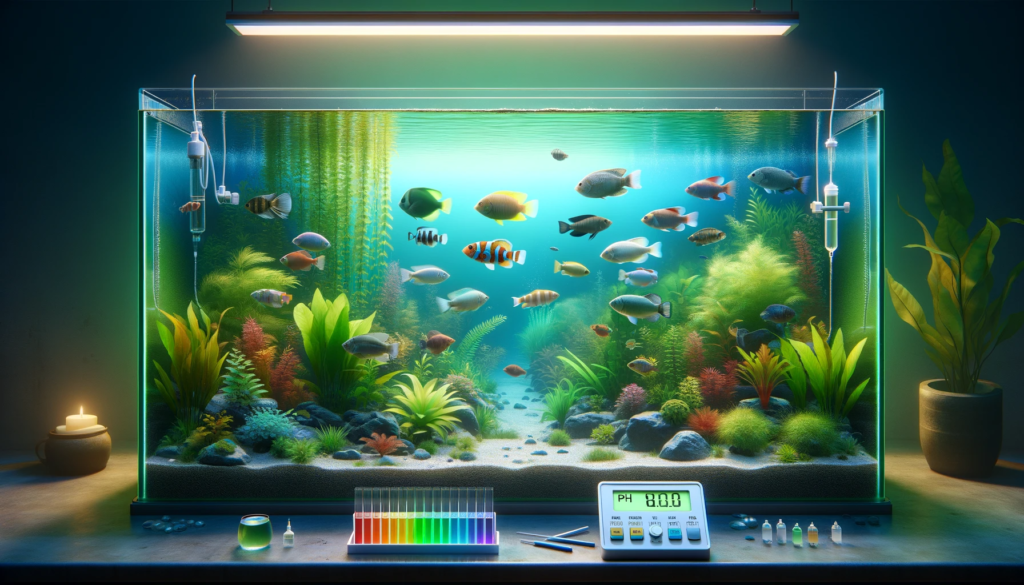
Maintaining the correct pH level in a freshwater aquarium is critical for the health and well-being of the aquatic inhabitants.
Strategies to adjust the pH include methods for both increasing and decreasing the water’s acidity or alkalinity.
This section will outline practical steps for raising and lowering pH, as well as the role of partial water changes in managing the aquarium’s pH balance.
Methods to Raise pH in Freshwater Aquariums
Aquarists looking to increase the pH level of their freshwater aquariums have several effective options at their disposal. These methods primarily focus on increasing the alkalinity of the water, which subsequently raises the pH level. It’s important to choose a method that suits the specific needs of the aquatic life in the tank.
Strategies for Raising pH
Add Bicarbonate Salts:
- Introducing sodium bicarbonate (baking soda) can effectively raise the pH level.
Use Crushed Coral or Limestone as Substrate:
- These materials slowly release calcium carbonate, which increases alkalinity and pH.
Incorporate Calcareous Rocks or Ornaments:
- Adding rocks or decorations made of calcareous material can also help in elevating the pH.
Monitoring and Adjusting pH Levels
Regular pH Testing:
- Consistently test the water’s pH to monitor changes and make informed adjustments.
Observing Fish Behavior:
- Watch for any signs of stress in fish, which can indicate issues with pH levels.
Gradual Adjustments:
- Make slow and steady changes to the water chemistry to avoid sudden pH shifts that can be harmful to aquatic life.
How to lower the pH level in a freshwater aquarium
To reduce the pH level in a freshwater aquarium, one may introduce natural elements such as driftwood or peat moss, which release tannic acids that gradually lower the water’s pH. This process not only mimics the natural environment of certain fish species but also does so without causing abrupt changes that can stress aquatic life.
Additionally, using a substrate designed to affect pH can help maintain more acidic conditions. Chemical pH adjusters are also available, but should be used cautiously, as overuse can lead to instability. Regular monitoring is vital to ensure the pH remains within a safe range for the aquarium’s inhabitants.
It’s essential to make any adjustments gradually and to understand the specific pH requirements of the fish and plants in your care.
Partial water changes to adjust the pH level in the aquarium
Regular partial water changes are a fundamental method for managing the pH level in your freshwater aquarium. They dilute substances that can cause pH fluctuations, maintaining a stable environment for your aquatic life.
To effectively adjust pH through water changes, consider the following steps:
– Determine the current pH level and the desired pH level for your aquarium.
– Calculate the volume of water to be changed to achieve the desired pH.
– For minor adjustments, change 10-15% of the water.
– For larger corrections, up to 25% can be changed.
– Use water that is of the correct pH and temperature to match your aquarium.
– Add the new water slowly to avoid shocking the fish.
– Re-test the pH after the water change to ensure the desired level is achieved.
Testing and Maintenance of pH Level
Monitoring the pH level in a freshwater aquarium is a critical component of fish health and tank stability. Regular testing with reliable pH testing kits provides aquarists with the necessary data to understand and manage the aquatic environment effectively.
Addressing the causes of pH fluctuations and understanding the implications of high or low pH values are vital to maintaining the delicate balance required for a thriving aquatic ecosystem.
How to test the pH of your aquarium water
The common sources of pH fluctuations in a freshwater fish tank
Understanding a fish tank’s pH fluctuations begins with recognizing the aquarium’s water chemistry’s dynamic nature, which is influenced by various internal and external factors.
The pH level in a freshwater aquarium can shift due to the water source, with tap or well water potentially having different pH values.
Substrates and decorations, such as gravel, sand, driftwood, and rocks, may also release substances that impact pH.
Filtration systems, especially those using activated carbon, can alter or stabilize pH by removing contaminants.
The presence of specific fish and plant species can contribute to pH changes, as can the use of chemical additives designed to adjust pH levels.
Regular monitoring and maintenance of pH are crucial for sustaining an environment conducive to the health and well-being of the aquatic life.
Maintaining a neutral pH level while using tap water
To have an optimum range of pH level while using tap water, you can follow these steps:
1. Test the pH level of your tap water using a pH testing kit or pH meter. This will give you an idea of the current pH level.
2. If the pH level of your tap water is not neutral (around 7), you can use a water conditioner or pH adjuster to bring it to a neutral level. These products are readily available at aquarium or gardening stores.
3. Follow the instructions on the water conditioner or pH adjuster product for proper dosing. Generally, you will need to add a specific amount of the product to your tap water and mix it well.
4. Allow the tap water to sit for a few hours before using it. This will help stabilize the pH level and ensure it remains neutral.
5. Before using the tap water, test the pH level again to confirm that it is neutral. Adjust if necessary using the water conditioner or pH adjuster.
6. Use the neutral tap water for your desired purpose, such as watering plants, filling aquariums, or other applications.
Remember to regularly test the pH level of your tap water to ensure it remains neutral over time.
The potential risks of having a high pH level in the aquarium
Having a high pH level in an aquarium can pose several potential risks to the fish and other aquatic life residing in it. Some of the risks include:
1. Altered biological processes: High pH levels can affect the biological processes occurring in the aquarium. Fish and other aquatic organisms have specific pH requirements for their survival and optimal functioning. A high pH level can disrupt these processes, leading to physiological stress and potentially impairing their overall health.
2. Ammonia toxicity: Ammonia is a toxic substance that is produced by fish waste and decaying organic matter in the aquarium. In a high pH environment, ammonia becomes more toxic as it shifts from its less toxic form, ammonium ion (NH4+), to its more toxic form, ammonia gas (NH3). This can lead to ammonia poisoning in fish, causing symptoms such as difficulty breathing, loss of appetite, and even death.
3. pH shock: Rapid changes in pH levels can cause pH shock to the fish and other aquatic organisms. If the pH level suddenly increases, it can lead to stress and potentially cause harm to the fish’s gills and other sensitive tissues. This stress weakens their immune system and makes them more susceptible to diseases and infections.
4. Calcium precipitation: High pH levels can lead to the precipitation of calcium and other minerals in the aquarium water. This can result in the formation of white deposits on the tank walls, decorations, and even on the fish themselves. These deposits can be unsightly and difficult to remove, and they can also affect the water quality and create an unhealthy environment for the fish.
5. Imbalanced water chemistry: A high pH level can indicate an imbalance in the water chemistry of the aquarium. It could be a sign of high alkalinity, which can affect the availability of essential nutrients and trace elements required for the well-being of the fish and other aquatic organisms. This imbalance can lead to nutrient deficiencies, stunted growth, and overall poor health.
To mitigate these risks, it is important to regularly monitor and maintain the pH level within the appropriate range for the specific species in the aquarium. This can be achieved through proper water testing, regular water changes, and the use of pH-adjusting products if necessary.
Factors Affecting pH Level in Freshwater Aquarium
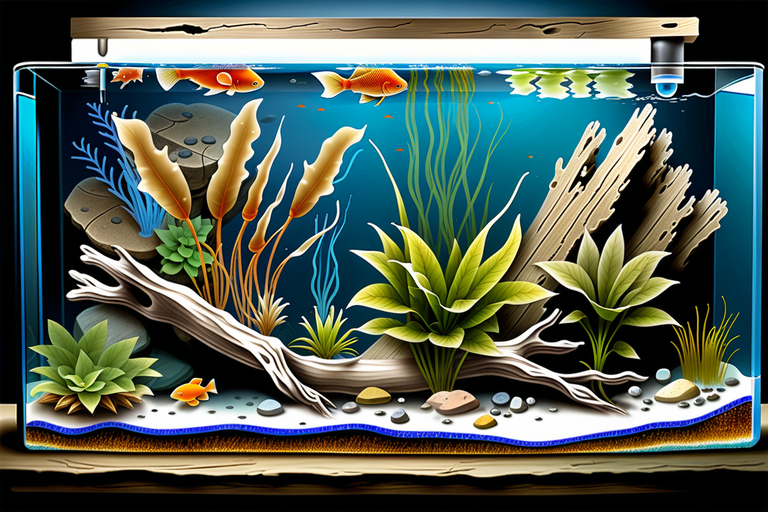
Maintaining optimal pH levels in a freshwater aquarium is critical for the health and survival of its inhabitants.
Various elements within the tank environment, including plants, decorations, and the use of chemical additives, can significantly influence the pH balance.
This section will explore how these components interact with the water chemistry, potentially raising or lowering pH levels and the implications for aquatic life.
How do aquariums plants affect PH levels?
Aquarium plants can have both direct and indirect effects on pH levels in the aquarium. Here are a few ways in which aquarium plants can affect pH:
1. Photosynthesis: During photosynthesis, plants absorb carbon dioxide (CO2) and release oxygen (O2). This process can help maintain a stable pH level in the aquarium by reducing the concentration of CO2, which can lower the acidity (pH) of the water. In well-planted aquariums, the photosynthesis process can help prevent pH fluctuations.
2. Nutrient absorption: Aquatic plants uptake nutrients such as nitrates, phosphates, and trace elements from the water column. Excessive levels of these nutrients can lead to the growth of algae, which can lower pH levels as they consume CO2 during respiration. By efficiently utilizing these nutrients, plants can help prevent pH fluctuations caused by algal growth.
3. Organic waste decomposition: Aquarium plants play a vital role in breaking down fish poop and other aquarium inhabitants. As plants consume this waste, they release carbon dioxide during respiration, which can lower the pH levels slightly. However, this effect is usually minimal and easily balanced by the plants’ photosynthetic activity.
It’s important to note that while aquarium plants can help stabilize pH levels, they are not the sole factor affecting pH in the aquarium. Other factors, such as water source, substrate, rocks, and the type of fish or other organisms present, can also influence pH levels. Regular monitoring of pH and proper water maintenance practices are essential for maintaining a healthy and stable aquarium environment.
Can aquarium decorations and rocks affect pH?
Yes, aquarium decorations and rocks can affect the pH of the water in an aquarium. Some decorations and rocks, such as certain types of limestone or coral, can release minerals into the water that can raise the pH and make it more alkaline.
On the other hand, some types of driftwood or certain rocks, such as granite, can release tannins or other acidic substances into the water, which can lower the pH and make it more acidic.
It is important to choose aquarium decorations and rocks that are safe for your specific fish species and are compatible with the desired pH level for your aquarium. Regular monitoring of the pH levels and making necessary adjustments is also important in maintaining a stable and suitable environment for your fish.
Other things that raise or lower PH levels in aquarium
Beyond the influence of decorations and rocks, multiple factors contribute to the fluctuation of pH levels in a freshwater aquarium, each playing a critical role in the water chemistry dynamics. These fluctuations can significantly impact the well-being of aquatic life. A clear understanding of these factors is crucial for maintaining a stable environment conducive to the health of your fish.
Here’s a succinct overview of the variables affecting aquarium pH levels:
Water Source
- Tap Water vs. Well Water
- Differences in mineral content and treatment processes.
- Different Source pH Values
- Variation in pH levels due to natural and human-induced factors.
Biological Factors
- Waste Decomposition
- Impact on water pH through the release of byproducts.
- Plant Respiration and Photosynthesis
- Influence on pH levels due to the exchange of gases and organic compounds.
Chemical Interactions
- Carbon Dioxide Levels
- Effect on water acidity when dissolved in water.
- Use of pH Adjusters or Buffers
- Methods to stabilize pH levels in different water systems.
Filtration System
- Filter Media Impact
- Role of various filter media in altering water pH.
- Carbon Filter Effects
- Influence of carbon filters on water quality and pH balance.
Optimizing pH Level in your Aquarium
Maintaining a stable pH level is crucial for the well-being of aquatic life in a freshwater aquarium. To achieve this stability, it is essential to understand the steps involved in monitoring and adjusting the pH to suit the specific needs of the fish and plant species housed within.
This section will outline the practical measures aquarists can take to optimize and maintain the desired pH balance in their tanks.
What are the steps to stabilize the pH level in the aquarium
To stabilize the pH level in an aquarium, follow these steps:
1. Test the pH: Use a pH test kit to measure the current pH level in the aquarium. This will give you a baseline to work with.
2. Research ideal pH range: Different fish species have different pH preferences. Research the preferred pH range for the fish in your aquarium to ensure you’re aiming for the right level.
3. Identify the cause: Determine what is causing the pH level to fluctuate. Common causes include tap water pH, decaying organic matter, or the presence of certain rocks or substrates that affect pH.
4. Adjust tap water pH: If the tap water pH is significantly different from the desired pH in the aquarium, you can use pH-adjusting products or buffering agents to bring it closer to the desired range. Follow the instructions on the product carefully and make gradual adjustments.
5. Maintain water quality: Cleaning the aquarium and remove any decaying organic matter, uneaten food, or waste. These can contribute to pH fluctuations.
6. Use a buffering agent: If the pH is consistently unstable, you can use a buffering agent specifically designed for aquariums. These products help maintain a stable pH level by preventing sudden changes.
7. Test and monitor: Regularly test the pH level in the aquarium to ensure it remains stable. This will allow you to make any necessary adjustments promptly.
8. Introduce pH-neutral rocks or substrates: If certain rocks or substrates are causing pH fluctuations, consider replacing them with pH-neutral alternatives such as sandston or lava rock.
9. Gradual changes: Avoid making sudden and drastic changes to the pH level, as this can stress the fish. Make adjustments gradually over time.
10. Seek professional advice: If you’re having difficulty stabilizing the pH level or if your fish appear stressed or unhealthy, consult with a knowledgeable aquarium professional or veterinarian for further guidance.
Remember, stability is key when it comes to pH levels in an aquarium. Sudden or extreme changes can be harmful to the fish, so it’s important to monitor and adjust gradually.
In conclusion, the management of pH levels is essential for the health and stability of freshwater aquariums. Regular testing and careful adjustment of the aquatic environment ensure the well-being of its inhabitants.
Understanding the factors that influence pH, including substrate, decorations, and biological processes, allows for effective intervention when necessary.
By fostering a consistent pH level, one can replicate the natural conditions of fish species and promote a thriving aquatic ecosystem.

